 Technology peripherals
Technology peripherals
 AI
AI
 Fight the problem of 'conceptual elegance'! Google releases new time perception framework: image recognition accuracy increased by 15%
Fight the problem of 'conceptual elegance'! Google releases new time perception framework: image recognition accuracy increased by 15%
Fight the problem of 'conceptual elegance'! Google releases new time perception framework: image recognition accuracy increased by 15%
Concept drift has always been a thorny problem in machine learning research. It refers to changes in data distribution over time, causing the effectiveness of the model to be affected. This situation forces researchers to constantly adjust models to adapt to new data distributions. The key to solving the problem of concept drift is to develop algorithms that can detect and adapt to changes in data in a timely manner.
One obvious case is the image display of the CLEAR non-steady state learning benchmark, which reveals the past ten years. Significant changes in the visual characteristics of objects over the course of the year.
This phenomenon is called "slow concept drift" and poses a severe challenge to object classification models. As the appearance or attributes of objects change over time, how to ensure that the model can adapt to this change and continue to classify accurately becomes the focus of research.

Recently, facing this challenge, Google AI’s research team proposed an optimization called MUSCATEL (Multi-Scale Temporal Learning) Driving methods, successfully improved model performance on large and ever-changing data sets. This research result has been published at AAAI2024.

Paper address: https://arxiv.org/abs/2212.05908
Currently, for The mainstream methods of probability drift are online learning and continuous learning (online and continue learning).
The main concept of these methods is to continuously update the model to adapt to the latest data to ensure the effectiveness of the model. However, this approach faces two main challenges.
These methods often focus only on the latest data, ignoring the valuable information contained in past data. In addition, they assume that the contribution of all data instances decays uniformly over time, which is not consistent with the actual situation.
The MUSCATEL method can effectively solve these problems. It assigns importance scores to training instances and optimizes the performance of the model in future instances.
To this end, the researchers introduced an auxiliary model that combines instances and their ages to generate scores. The auxiliary model and the main model learn collaboratively to solve two core problems.
This method performs well in practical applications. In a large real-world dataset experiment covering 39 million photos and lasting for 9 years, it outperformed other steady-state learning baselines. method, the accuracy increased by 15%.
At the same time, it also shows better results than the SOTA method in two non-stationary learning data sets and continuous learning environments.
Challenges of concept drift to supervised learning
To study the challenges of concept drift to supervised learning, researchers conducted a photo classification task Two methods, offline training and continue training, were compared, using about 39 million social media photos from 10 years.
As shown in the figure below, although the initial performance of the offline training model is high, the accuracy decreases over time, and the understanding of early data is reduced due to catastrophic forgetting.
On the contrary, although the initial performance of the continuous training model is lower, it is less dependent on old data and degrades faster during testing.
This shows that the data evolves over time and the applicability of the two models decreases. Concept drift poses a challenge to supervised learning, which requires continuous updating of the model to adapt to changes in data.
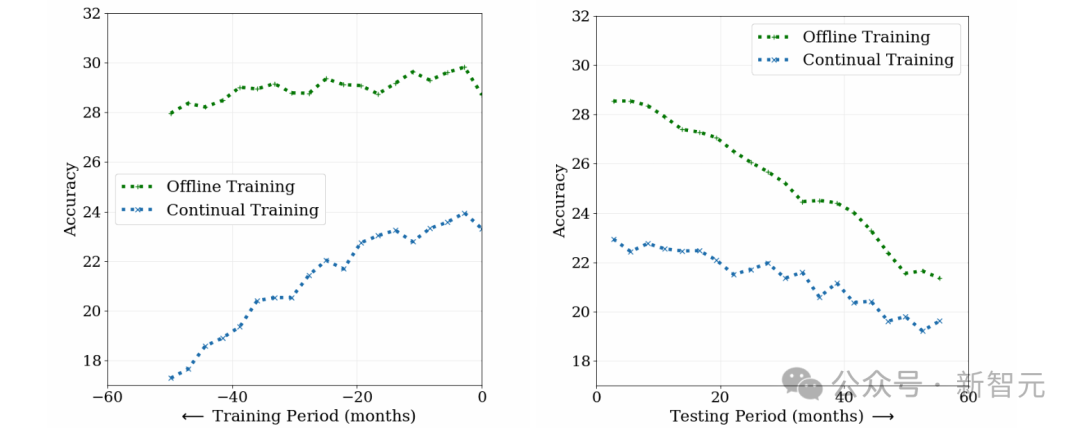
MUSCATEL
##MUSCATEL is an innovative approach to the concept of slowness The problem of drift. It aims to reduce the performance degradation of the model in the future by cleverly combining the advantages of offline learning and continuous learning.
In the face of huge training data, MUSCATEL shows its unique charm. It not only relies on traditional offline learning, but also carefully regulates and optimizes the impact of past data on this basis, laying a solid foundation for the future performance of the model.
In order to further improve the performance of the main model on new data, MUSCATEL introduces an auxiliary model.
Based on the optimization goals in the figure below, the training auxiliary model assigns weights to each data point based on its content and age. This design enables the model to better adapt to changes in future data and maintain continuous learning capabilities.
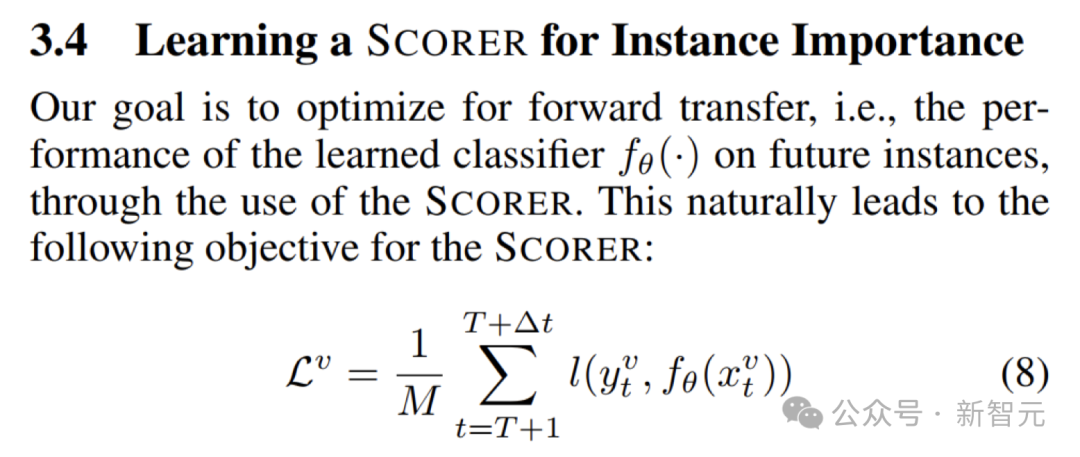
In order to co-evolve the auxiliary model and the main model, MUSCATEL also adopts a meta-learning strategy.
The key to this strategy is to effectively separate the contribution of sample instances and age, and to set the weights by combining multiple fixed decay time scales, as shown in the figure below.
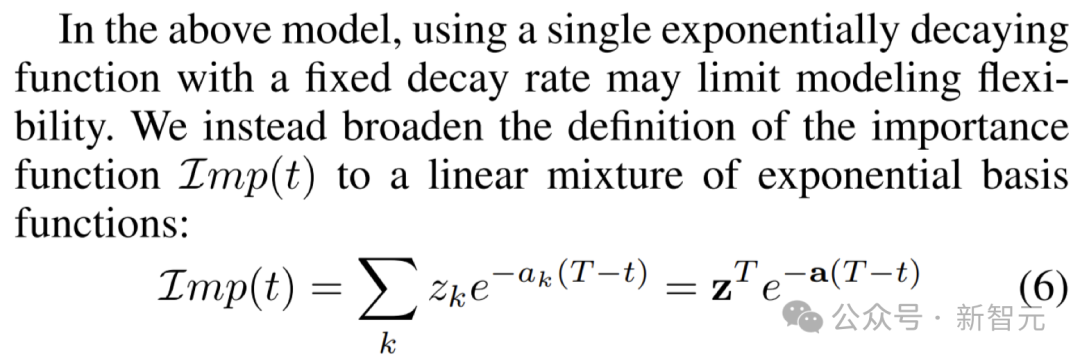
In addition, MUSCATEL also learns to "distribute" each instance to the most suitable time scale to achieve more Precise learning.
Instance Weight Score
As shown in the figure below, in the CLEAR object recognition challenge, the learned auxiliary model successfully adjusted the weight of the object: The weight of objects with the new appearance is increased, and the weight of objects with the old appearance is decreased.

Through gradient-based feature importance evaluation, it can be found that the auxiliary model focuses on the subject in the image, rather than the background or the instance age-independent characteristics, thereby proving its effectiveness.

A significant breakthrough in large-scale photo classification tasks
The large-scale photo classification task was studied on the YFCC100M dataset Photo classification task (PCAT) uses the data of the first five years as the training set and the data of the last five years as the test set.
Compared with unweighted baselines and other robust learning techniques, the MUSCATEL method shows obvious advantages.
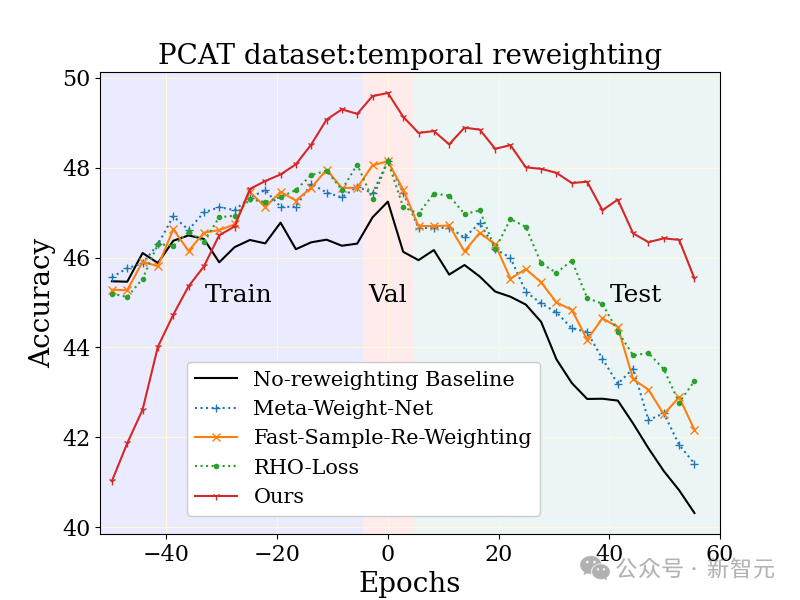
#It is worth noting that the MUSCATEL method consciously adjusts the accuracy of data from the distant past in exchange for a significant improvement in performance during testing. This strategy not only optimizes the model's ability to adapt to future data, but also shows lower degradation during testing.
Validate broad usability across datasets
The dataset for the non-stationary learning challenge covers a variety of data sources and modalities, including photos , satellite images, social media text, medical records, sensor readings and tabular data, the data size also ranges from 10k to 39 million instances. It is worth noting that the previous best method may be different for each data set. However, as shown in the figure below, in the context of diversity in both data and methods, the MUSCATEL method has shown significant gain effects. This result fully demonstrates the broad applicability of MUSCATEL.
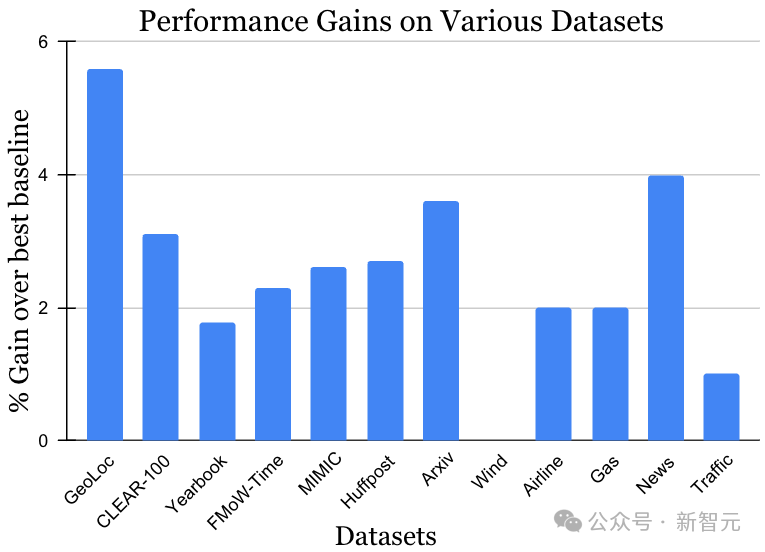
Expand continuous learning algorithms to cope with large-scale data processing challenges
When faced with mountains of When dealing with large-scale data, traditional offline learning methods may feel inadequate.
With this problem in mind, the research team cleverly adapted a method inspired by continuous learning to easily adapt to the processing of large-scale data.
This method is very simple, which is to add a time weight to each batch of data and then update the model sequentially.
Although there are still some minor limitations in doing this, such as model updates can only be based on the latest data, the effect is surprisingly good!
In the photo classification benchmark test below, this method performed better than the traditional continuous learning algorithm and various other algorithms.
Moreover, since its idea matches well with many existing methods, it is expected that when combined with other methods, the effect will be even more amazing!
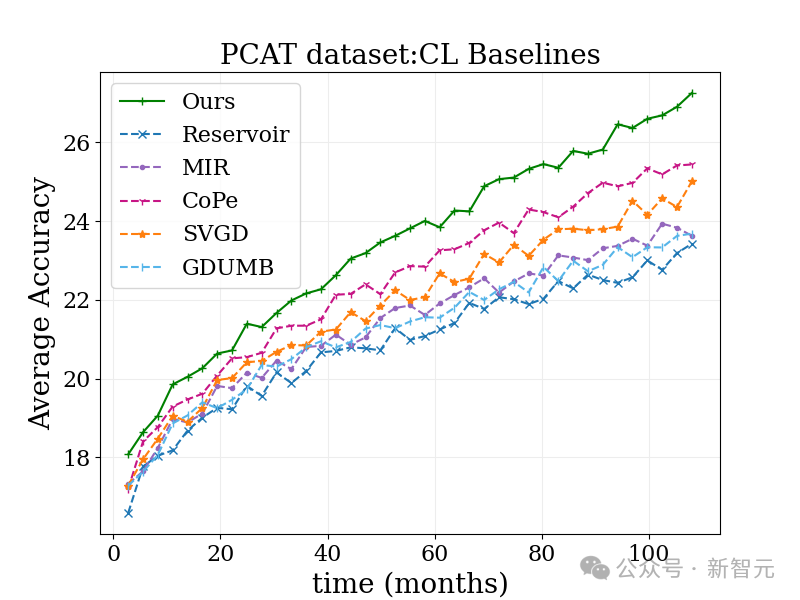
# Overall, the research team successfully combined offline and continuous learning to solve the data drift problem that has long plagued the industry.
This innovative strategy not only significantly alleviates the "disaster forgetting" phenomenon of the model, but also opens up a new path for the future development of large-scale data continuous learning, and provides a new direction for the entire field of machine learning. Injected new vitality.
The above is the detailed content of Fight the problem of 'conceptual elegance'! Google releases new time perception framework: image recognition accuracy increased by 15%. For more information, please follow other related articles on the PHP Chinese website!

Hot AI Tools

Undresser.AI Undress
AI-powered app for creating realistic nude photos

AI Clothes Remover
Online AI tool for removing clothes from photos.

Undress AI Tool
Undress images for free

Clothoff.io
AI clothes remover

AI Hentai Generator
Generate AI Hentai for free.

Hot Article

Hot Tools

Notepad++7.3.1
Easy-to-use and free code editor

SublimeText3 Chinese version
Chinese version, very easy to use

Zend Studio 13.0.1
Powerful PHP integrated development environment

Dreamweaver CS6
Visual web development tools

SublimeText3 Mac version
God-level code editing software (SublimeText3)

Hot Topics
 1359
1359
 52
52
 How to correctly display the locally installed 'Jingnan Mai Round Body' on the web page?
Apr 05, 2025 pm 10:33 PM
How to correctly display the locally installed 'Jingnan Mai Round Body' on the web page?
Apr 05, 2025 pm 10:33 PM
Using locally installed font files in web pages Recently, I downloaded a free font from the internet and successfully installed it into my system. Now...
 Does H5 page production require continuous maintenance?
Apr 05, 2025 pm 11:27 PM
Does H5 page production require continuous maintenance?
Apr 05, 2025 pm 11:27 PM
The H5 page needs to be maintained continuously, because of factors such as code vulnerabilities, browser compatibility, performance optimization, security updates and user experience improvements. Effective maintenance methods include establishing a complete testing system, using version control tools, regularly monitoring page performance, collecting user feedback and formulating maintenance plans.
 Where to get the material for H5 page production
Apr 05, 2025 pm 11:33 PM
Where to get the material for H5 page production
Apr 05, 2025 pm 11:33 PM
The main sources of H5 page materials are: 1. Professional material website (paid, high quality, clear copyright); 2. Homemade material (high uniqueness, but time-consuming); 3. Open source material library (free, need to be carefully screened); 4. Picture/video website (copyright verified is required). In addition, unified material style, size adaptation, compression processing, and copyright protection are key points that need to be paid attention to.
 How to select a child element with the first class name item through CSS?
Apr 05, 2025 pm 11:24 PM
How to select a child element with the first class name item through CSS?
Apr 05, 2025 pm 11:24 PM
When the number of elements is not fixed, how to select the first child element of the specified class name through CSS. When processing HTML structure, you often encounter different elements...
 Why does negative margins not take effect in some cases? How to solve this problem?
Apr 05, 2025 pm 10:18 PM
Why does negative margins not take effect in some cases? How to solve this problem?
Apr 05, 2025 pm 10:18 PM
Why do negative margins not take effect in some cases? During programming, negative margins in CSS (negative...
 What application scenarios are suitable for H5 page production
Apr 05, 2025 pm 11:36 PM
What application scenarios are suitable for H5 page production
Apr 05, 2025 pm 11:36 PM
H5 (HTML5) is suitable for lightweight applications, such as marketing campaign pages, product display pages and corporate promotion micro-websites. Its advantages lie in cross-platformity and rich interactivity, but its limitations lie in complex interactions and animations, local resource access and offline capabilities.
 How to use the shape-outside attribute of CSS to achieve the display effect of gradually shortening text?
Apr 05, 2025 pm 10:54 PM
How to use the shape-outside attribute of CSS to achieve the display effect of gradually shortening text?
Apr 05, 2025 pm 10:54 PM
Implementing the display effect of gradually shortening text In web design, how to achieve a special text display effect to make the text length gradually shortening? This effect...
 How to solve the problem of loading when PS is started?
Apr 06, 2025 pm 06:36 PM
How to solve the problem of loading when PS is started?
Apr 06, 2025 pm 06:36 PM
A PS stuck on "Loading" when booting can be caused by various reasons: Disable corrupt or conflicting plugins. Delete or rename a corrupted configuration file. Close unnecessary programs or upgrade memory to avoid insufficient memory. Upgrade to a solid-state drive to speed up hard drive reading. Reinstalling PS to repair corrupt system files or installation package issues. View error information during the startup process of error log analysis.



